When late spring arrives and turkey hunting seasons come to a close across much of the country, northern bruins are coming out of hibernation and beginning a new year of life.
What does this mean for bowhunters? Spring bear seasons are right around the corner and can produce some of the most action-packed bowhunting in North America. There are many places in the Lower 48, Canada and Alaska where bear populations are soaring, and for the dedicated bowhunter, North America offers up a buffet of endless bear hunting opportunities.
Find the Bears
Finding areas with high bear populations isn’t hard. North American bear populations, in most cases, are very high, and success rates on high-quality bear hunts are equally as good. The real challenge is locating an area that has the potential to produce a monster bear.
I’ve been on several spring bear hunts and have had some great success, but I never knew what I was missing in terms of pursuing the real giants. And while I loved spring black bear hunting, it quickly jumped up on my must-do list when I started seeking out those hard-to-kill monsters.
Match the Hunt to Your Style
Many people who decide to partake in a spring bear hunt will end up booking a hunt with an outfitter. That could mean a drop-camp hunt, a spot-and-stalk adventure, or the more traditional baited hunt. I have done my fair share of spot-and-stalk and baited hunts and enjoy them both.
Spot-and-stalk is typically done in areas that don’t allow baiting for bears, or in areas that are conducive to spotting the bears being able to get bowhunting-close to them. Coastal bears in Alaska are typically hunted with spot-and-stalk. This is also the preferred method in British Columbia where baiting is not allowed. The bonus to spot-and-stalk is being able to put glass on multiple bears and go after the one you want. Just know that the one you want might take you an entire trip to find, and sometimes your bino lenses will never scan up a true giant.
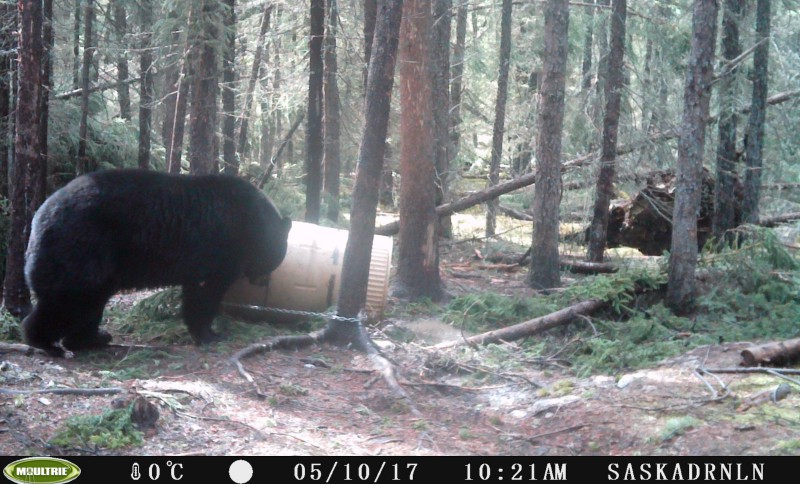
A properly set up trail camera over a bait site is crucial, especially for locating giant bears. This monster boar dwarfs the bait barrel and would be a true bowhunting trophy.
Where baiting is allowed, the season will typically run through the bears’ rutting season, which means big boars will scent-check bait sites looking for ready-to-breed sows. Baiting bears allows the bowhunter the opportunity to hunt in very remote, dense forest locations — areas where spot-and-stalk hunting would be very difficult. It also gives bowhunters the chance to really observe bear behavior.
While I enjoy both, my favorite is a baited black bear bowhunt. Why? I like being up close and personal with multiple bears on a hunt, and I like observing how bears interact with each other. I also like the fact that, whether I’m baiting on my own or using an outfitter, a trail camera can be placed over a bait. A well-placed trail cam tells me if a big boar is dominating the bait. Of course, anything is possible during the rut, but early in the season big boars can get brave and lay claim to a bait site.
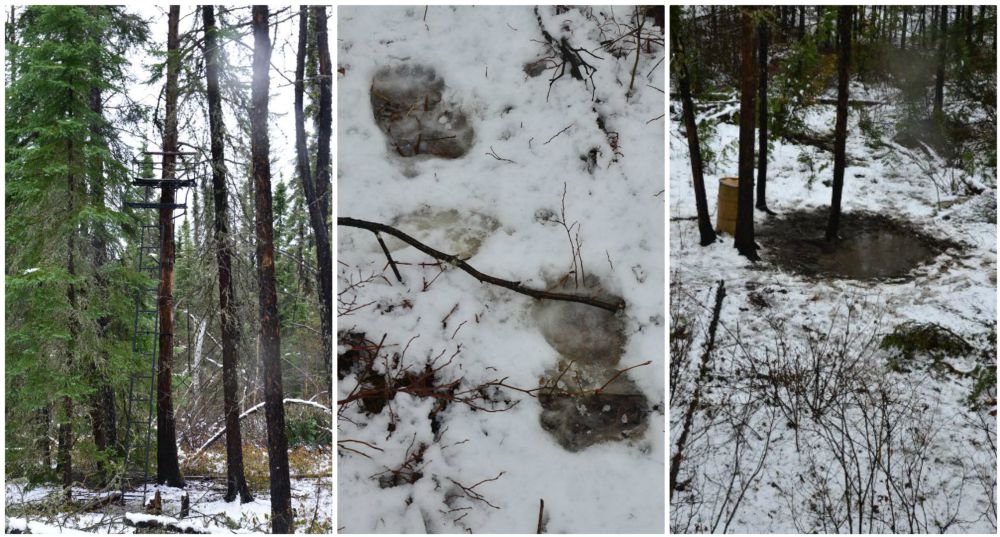
Sure, bear hunting from a ladder stand is similar to waiting on a whitetail, except deer can't climb trees and won't eat you.
In a spot-and-stalk scenario, if I see a good-sized bear, I tend to go after it because I might not get another solid opportunity with my bow. This adds an element of pressure that often causes me to rush my hunt and take a shot on a bear I would normally pass. Again, it’s all about matching your bear hunt to your preferred hunting style. Whitetail hunters accustomed to hunting from a treestand will love being perched 20 feet up a pine, but western go-getters might get bored with sitting on stand for hours at a time. Keep your hunt style in mind when figuring spring bear plans.
Choosing the Right Outfitter
What sets most bear outfitters apart — and trust me, I’ve used several — is their ability to put clients on giant bears. There are many outfitters who have high volumes of bears in their camps, but not very many can offer a true opportunity at those animals that push the measuring tape to the 7-foot mark.
I hear people talk all the time about 7-foot black bears. Tales of these bruins are as common as Budweiser at a professional sporting event, but the truth of the matter is there just aren’t many bears that size killed each year. Taking a true 7-foot bear is like taking a 170-inch whitetail buck. It just doesn’t happen very often.
I have hunted with a number of great bear hunting outfitters over the years, and I reached out to a pair of them to pick their brains. Steve White, owner of Willow Air (www.willowair.com), has a guide and outfitting business in Alaska. Mike Grundman with SaskAdrenaline Outfitters (www.realadrenaline.com) runs a successful operation in Saskatchewan, Canada. These guys are true professionals and pride themselves on being able to help their clients get that once-in-a-lifetime chance at taking a giant bear.
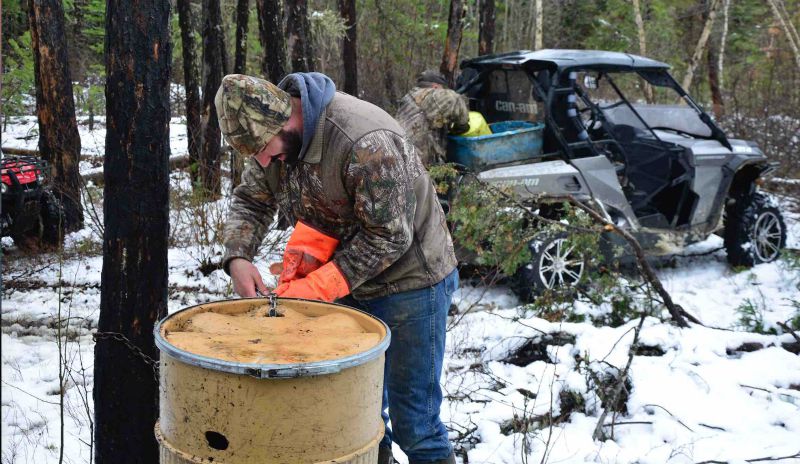
When choosing a bait site on a DIY hunt, look for a remote spot close to thick cover or the bear’s sanctuary. A natural travel corridor also takes a good bait site to the next level.
I have personally been on four bears hunts with Steve White, and I have been lucky enough to take big bears on each of those trips. I asked Steve if he could give me three tips hunters should follow in order to be successful while chasing bears in Alaska. Here’s what he said.
“If you’re spot-and-stalk hunting for big bears, find a vantage point close to camp, stay there and glass,” he said. “Do not walk around. The more you travel, the more you stink up the country. Big black bears do not like to cross your tracks. The more you walk around, the farther you have to go to find bears. When you spot a big bear, make a plan, play the wind and only go after a bear when you are sure it is the bear you want. Be sure the stalk yields a chance at success.
“Secondly, if you’re hunting big bears over bait, the big boars are usually killed when you have a sow in heat coming to the bait. If a sow comes to your bait that does not have cubs, do not shoot her. Also, be sure to stay stealthy. You don’t want to run her off the bait. Keep still and quiet. Eventually, she will lead a big boar to the bait. This may take a bit of time, but during this spring season at some point she is going to come into heat. The boar may not be interested in the bait at all, but he will follow her in.
“Lastly, if you want a big bear, you have to be patient and be prepared to go home empty-handed. The way to kill a big bear is to stop shooting small bears.”
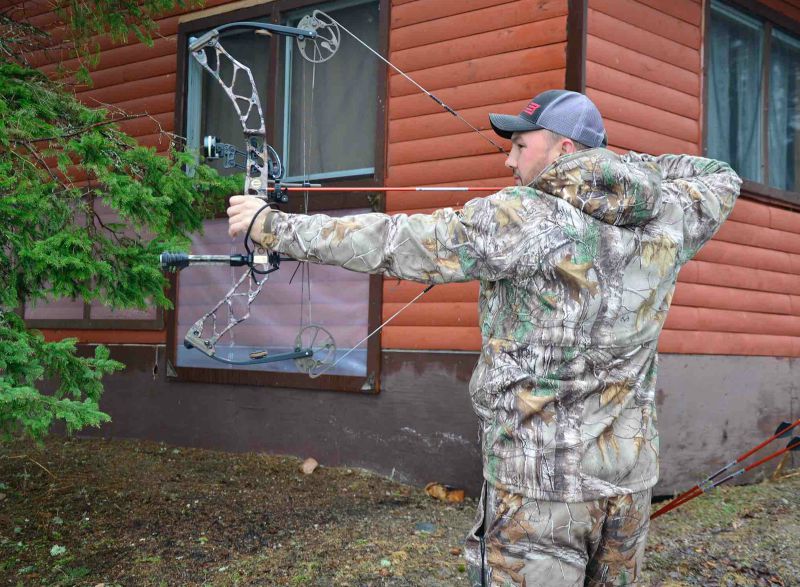
When chasing giant bruins, shot placement is crucial. Deflate a big boar’s lungs and he will often die within sight. Practice sessions keep you sharp and ready during a hunt.
I have hunted with Mike Grundman two years in a row and have killed my two biggest black bears on those hunts. What really impressed me on my trips with Mike is the volume of bears he has that are truly 7-foot caliber. I asked Mike for tips on how to get an opportunity at big black bears while hunting over bait. This is Mike’s advice:
“After a lot of trial and error, I came up with a formula I use for finding long-lasting bait sites,” he explained. “There are three major factors that I like to stick to when finding new sites. First, the place needs to be a sanctuary for a bear; a place they can come to and feel safe. Bears, especially big bears, need to be able to come to a site and not feel pressured. I try to place my baits close to thick cover or in the middle of the bear’s sanctuary. If the bear feels it can escape in case of danger, it is more willing to feed during daylight hours.
“Second, I like to get remote, which means I try to target bears with little or no pressure on them. The farther I can get off the beaten path, the better the bear hunting.
“Third and most important is a natural travel corridor. Find a spot that has the first two characteristics above but is also on top of, or close to, the bear’s natural travel path, and you’re in the money. A bait in the right spot will have new bears showing up regularly. This will also cause the regulars to the site to be frequent visitors. Resident sows are the best thing for a bait when the rut is firing up. If you can get a hot sow to stick to a bait, you can be sure it is only a matter of time until that big old boar will show up.”
Do Your Homework
Both Steve and Mike are as seasoned as they come, and their advice is sound. Both talk about the importance of light pressure. Bears like to be alone. The older and more mature a big boar becomes, the less he wants to feel or experience pressure. Bears prefer to live where they feel comfortable. If something happens that changes their feeling of safety, they will move or leave the area.
The second thing both Steve and Mike noted was the importance of being able to locate areas that hold mature sows during spring. Big boars live solitary lives, so the best chance you have of getting them to a bait is when a sow in heat pulls them in during the rut. Of course, some will lay claim to a site and get comfortable if they’re not pressured.
Another tip both men brought up is to carefully select your bait-site locations. A water source in remote country is typically a great location to find good bear activity. Lakes, creeks, rivers or even a remote beaver pond are all places for bears to spend a lot of their time. Look for claw marks on trees or heavily used trails to determine if there are bears in the area. The closer you can get to a bear's home, the more effective you are going to be during hunting season.
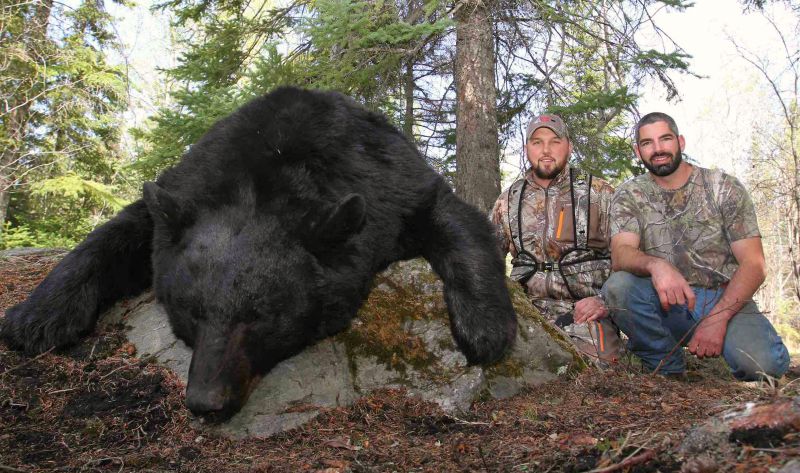
The author (left) books hunts with Mike Grundman (right) of SaskAdrenaline Outfitters for one reason: giant black bears.
If you are looking for the right area for a do-it-yourself hunt, or if you’re trying to find the right outfitter to book your bear hunt, you have to do your homework. There are plenty of places out there where you can hunt large numbers of bears, but finding that once-in-a-lifetime giant requires research. I’ve done a little for you, but don’t be afraid to surf the web, makes some calls and start looking for that honey pot at the end of the rainbow.
Editor’s note: Want a treestand glimpse of what it’s like to bowhunt black bears with Mike Grundman with SaskAdrenaline Outfitters? Check out the amazing clip below; you won’t believe what happens at the 2:38 mark of the 7-minute video.






